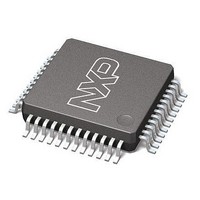LPC11C22FBD48/301,151 NXP Semiconductors, LPC11C22FBD48/301,151 Datasheet - Page 20

LPC11C22FBD48/301,151
Manufacturer Part Number
LPC11C22FBD48/301,151
Description
Microcontrollers (MCU) CAN Transceiver MCU 16K Flash
Manufacturer
NXP Semiconductors
Datasheet
1.LPC11C22FBD48301151.pdf
(62 pages)
Specifications of LPC11C22FBD48/301,151
Processor Series
LPC11Cx2
Core
ARM Cortex-M0
Data Bus Width
32 bit
Program Memory Type
Flash
Program Memory Size
16 KB
Data Ram Size
8 KB
Interface Type
CAN, I2C, SPI, UART
Maximum Clock Frequency
50 MHz
Number Of Programmable I/os
36
Number Of Timers
4
Operating Supply Voltage
3.3 V
Maximum Operating Temperature
+ 85 C
Mounting Style
SMD/SMT
Development Tools By Supplier
OM13012,598
Minimum Operating Temperature
- 40 C
Lead Free Status / Rohs Status
Details
Other names
935294284151
NXP Semiconductors
LPC11CX2_CX4
Product data sheet
7.11.2.1 Features
7.11.2.2 Normal mode
7.11.2.3 Silent mode
7.11.2.4 Undervoltage protection
7.11.2.5 Thermal protection
7.11.2 On-chip, high-speed CAN transceiver
Remark: The on-chip CAN transceiver is available on parts LPC11C22/C24 only.
Compared to the LPC11C12/C14, the LPC11C22/C24 supports fewer GPIO functions,
and in addition, one counter/timer match function is removed to allow interfacing the CAN
high-speed transceiver to the CAN bus. See
A LOW level on pin STB selects Normal mode. In this mode, the transceiver is able to
transmit and receive data via the bus lines CANH and CANL (see
differential receiver converts the analog data on the bus lines into digital data which are
received by the CAN_RXD input of the C_CAN controller.
A HIGH level on pin STB selects Silent mode. In Silent mode the transmitter is disabled,
releasing the bus pins to recessive state. All other functions, including the receiver,
continue to operate as in Normal mode. Silent mode can be used to prevent a faulty
C_CAN controller from disrupting all network communications.
Should V
(V
from the bus (zero load) until V
The output drivers are protected against overtemperature conditions. If the virtual junction
temperature exceeds the shutdown junction temperature, T
drivers will be disabled until the virtual junction temperature falls below T
•
•
•
•
•
•
uvd(VCC)
The C_CAN API includes the following functions:
– C_CAN set-up and initialization
– C_CAN send and receive messages
– C_CAN status
– CANopen object dictionary
– CANopen SDO expedited communication
– CANopen SDO segmented communication primitives
– CANopen SDO fall-back handler
Flash ISP programming via C_CAN supported.
Data rates of up to 1 Mbit/s
Fully ISO 11898-2 compliant
Undervoltage detection and thermal protection
Low ElectroMagnetic Emission (EME) and high ElectroMagnetic Immunity (EMI)
CC
and V
or VDD_CAN drop below their respective undervoltage detection levels
All information provided in this document is subject to legal disclaimers.
uvd (VDD_CAN)
Rev. 3 — 27 June 2011
; see
CC
and VDD_CAN have recovered.
Table
8), the transceiver will switch off and disengage
Table 4
32-bit ARM Cortex-M0 microcontroller
and
Figure
LPC11Cx2/Cx4
j(sd)
(see
1.
Figure
Table
© NXP B.V. 2011. All rights reserved.
j(sd)
28). The
8), the output
.
20 of 62















